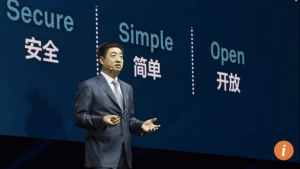
Huawei Technologies, the world’s largest telecommunications equipment supplier, expects to build a US$10-billion-a-year business in cloud computing infrastructure and services by 2020 to tap rising global demand.
Deputy chairman Ken Hu Houkun, acting chief executive under Huawei’s rotating leadership structure, on Wednesday said the company was on track with that goal since that operation was already growing faster than its other business segments.
Reaching that scale would enable Shenzhen-based Huawei to mount a strong challenge to the current crop of leading global suppliers of cloud equipment, including Hewlett-Packard Enterprise, Cisco Systems and Dell.
“We see huge and clear opportunities,” Hu said at a Huawei event in Shanghai. “The new trend for traditional industries, such as manufacturing, health care and education, as well as the public sector, is to upgrade their operations by using cloud computing technologies and solutions.”
Cloud computing enables companies to buy, sell, lease or distribute online a range of software and other digital resources as an on-demand service, just like electricity from a power grid. These resources are managed inside data centres. “Cloud” refers to the internet as depicted in computer network diagrams.
Global spending on cloud infrastructure products, including servers, enterprise storage systems and Ethernet switches, rose 22 per cent to US$29 billion last year, up from US$24 billion in 2014, according to data from research firm IDC.
The new trend for traditional industries…is to upgrade their operations by using cloud computing technologies and solutions
Kuba Stolarski, a research director at IDC, said in a report in April that the global cloud information technology infrastructure market would keep seeing strong double-digit growth. “Public cloud [as a service] acceptance and adoption will continue on a steady pace into the next decade,” he said.
That trend certainly resonates with the mainland Chinese government, which formally adopted the country’s 13th Five-Year Plan in March. Beijing is pushing to revitalise domestic industries through their adoption of advances in internet-based technologies, including cloud computing and e-commerce.
Hu said Huawei’s sharpened focus on cloud infrastructure and services is supported by the firm’s strong research and development in servers, semiconductor design and open-source computing architecture.
He added that Huawei expects 85 per cent of enterprises around the world will use cloud services by 2025, which augurs well for the company’s domestic and international cloud expansion initiatives.
By the end of December, Huawei counted more than 500 enterprise cloud partners, including systems integrators, that it works with to deliver cloud services in the government, utility, telecoms, energy, education and finance sectors around the world. In the same period, the company said it had built about 255 cloud data centres.
Indian e-commerce company Flipkart, French digital advertising firm Criteo and Norwegian technology services provider Evry are among the latest users of its data centre solutions.
Huawei in July announced that its revenue for the first six months of this year jumped 40 per cent to 245.5 billion yuan (HK$285.09 billion), up from 175.9 billion yuan in the same period last year, on the back of steady sales increases at its core carrier, enterprise and consumer businesses.
That marked the biggest year-on-year revenue growth for Huawei since the privately held company started reporting its first-half sales performance in 2011.
Hu did not disclose Huawei’s first-half revenue from cloud computing infrastructure and services.
Huawei, with operations in more than 170 countries and territories, predicted in April that its total revenue will reach US$70 billion this year, up from US$60.8 billion last year.
